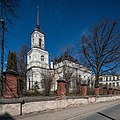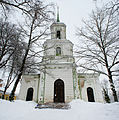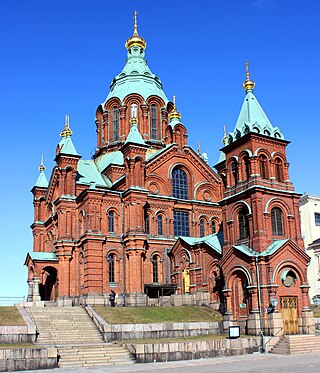
The Orthodox Church of Finland or Finnish Orthodox Church is an autonomous Eastern Orthodox archdiocese of the Ecumenical Patriarchate of Constantinople. The church has a legal position as a national church in the country, along with the Evangelical Lutheran Church of Finland.

Toompea is a hill in the central part of Tallinn, the capital city of Estonia. The hill has an area of 7 hectares and is about 20–30 metres higher than the surrounding areas. Toompea is part of the medieval Tallinn Old Town, a UNESCO World Heritage Site.

Kyiv-Pechersk Lavra or Kyievo-Pecherska Lavra, also known as the Kyiv Monastery of the Caves, is a historic Eastern Orthodox Christian monastery which gave its name to one of the city districts where it is located in Kyiv.

The Cathedral of the Dormition, also known as the Assumption Cathedral or Cathedral of the Assumption, is a Russian Orthodox church dedicated to the Dormition of the Theotokos. It is located on the north side of Cathedral Square of the Moscow Kremlin in Russia, where a narrow alley separates the north from the Patriarch's Palace with the Twelve Apostles Church. Separately in the southwest, also separated by a narrow passage from the church, stands the Palace of Facets. The cathedral is regarded as the mother church of Muscovite Russia.

The Catholic Church in Estonia is the national branch of the worldwide Catholic Church, under the spiritual leadership of the Pope in Rome.
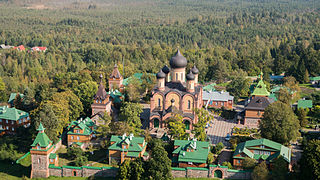
Pühtitsa Convent is a Russian Orthodox convent in Eastern Estonia between Lake Peipus and the Gulf of Finland. A small Orthodox Christian church was built in Pühtitsa in the 16th century. The convent was founded in 1891 and has grown into the largest Orthodox community in the Baltic states.

Uspenski Cathedral is a Greek Orthodox or Eastern Orthodox cathedral in Helsinki, Finland, and main cathedral of the Orthodox Church of Finland, dedicated to the Dormition of the Theotokos. Its name comes from the Old Church Slavonic word uspenie, which denotes the Dormition. It is the largest Greek Orthodox church in both Northern and Western Europe.

St George's Cathedral is an Antiochian Orthodox church in Albany Street, St Pancras, in the London Borough of Camden. Built to the designs of James Pennethorne, it was consecrated as an Anglican place of worship called Christ Church in 1837. It became an Orthodox cathedral in 1989.
Cathedral of the Dormition of the Theotokos or Cathedral of the Dormition of the Mother of God may refer to:

The Forty Martyrs Armenian Cathedral of Aleppo, Syria, is a 15th-century Armenian Apostolic church located in the old Christian quarter of Jdeydeh. It is significant among the Armenian churches for being one of the oldest active churches in the Armenian diaspora and the city of Aleppo. It is a three-nave basilica church with no dome. Its bell tower of 1912, is considered to be one of the unique samples of the baroque architecture in Aleppo.

Tartu Cathedral, earlier also known as Dorpat Cathedral, is a former Catholic church in Tartu (Dorpat), Estonia. The building is now an imposing ruin overlooking the lower town. About a third of the cathedral has been renovated. In the part of it that has been renovated is now located the museum of the University of Tartu, which the university also uses for major receptions.

The Assumption or Dormition Cathedral was the main Orthodox church of Kharkiv until the construction of the Annunciation Cathedral in 1901. The cathedral stands on the University Hill by the bank of the Lopan River and dominates the entire downtown. The Neoclassical cathedral bell tower, built in the 1820s and 1830s to a height of 90 meters, remained the tallest building in the city until the 21st century. The cathedral is the only building in Kharkiv visited by almost all Emperors of Russia, starting with Catherine the Great.

The Russian Orthodox Cathedral of the Dormition of the Mother of God and All Saints is the cathedral of the Russian Orthodox Diocese of Sourozh.

Moscow Kremlin Museums is a major state-run museum in Moscow Kremlin. Its roots lie in the Kremlin Armoury museum founded in 1806, the current form of the museum started in 1991. The Head of the museum is Yelena Gagarina, daughter of cosmonaut Yuri Gagarin. There were 424,922 visitors to the Kremlin Museums in 2020, a drop of 86 percent from 2019 due to the COVID-19 pandemic, but it still ranked 46th on the List of most-visited art museums in the world in 2020.
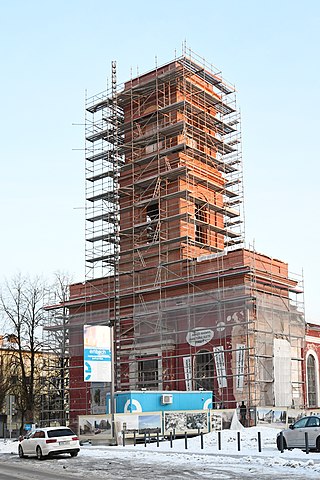
St Mary's Church is a 19th century church of the Estonian Evangelical Lutheran Church located in Tartu, Estonia.
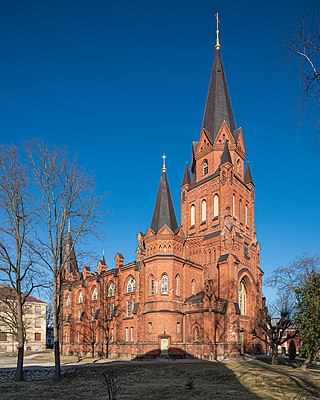
St Peter's Church is a 19th-century church of the Estonian Evangelical Lutheran Church located in Tartu, Estonia.

St Paul's Church is a 20th-century church of the Estonian Evangelical Lutheran Church located in Tartu, Estonia.

St Alexander's Church, formally known as The Parish Church of St Alexander Nevsky is a church of the Estonian Apostolic Orthodox Church in Tartu, Estonia.

The Alexander Nevsky Church is an orthodox church in the Haapsalu old cemetery, Estonia. It was built to a design by Alexander Krasovsky in a typical Russian Revival style between 1896 and 1897, during the period when the country was part of the Russian Empire. It is dedicated to Saint Alexander Nevsky who in 1242 won the Battle of the Ice on Lake Peipus, in the territorial waters of present-day Estonia. The late Estonian Metropolitan, Cornelius (Jakobs), started his priestly ministry in the church.

The Tartu Credit Center Massacre was the mass execution of 19 people in the basement of the former Credit Center in Tartu, Estonia, on 14 January 1919.





